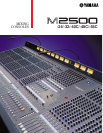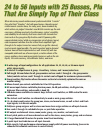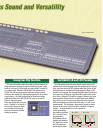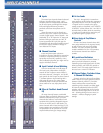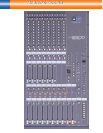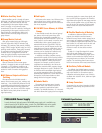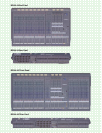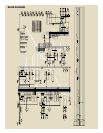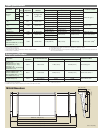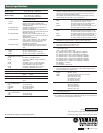
PW3000MA Power Supply
A newly developed, high-performance PW3000MA power supply unit is available as an
optional accessory for the M2500 mixing console. Two PW3000MA units can be parallel
connected so that if one fails the other will automatically take over — with no need for
any extra automatic switchover equipment.
Rear Panel
PW3000MA Specifications
Power consumption
U.S. and Canadian model: 120V AC,60Hz / 500W 600 VA
European model: 230V AC, 50Hz/ 500W
Australian model: 240V AC, 50Hz/ 500W
Dimensions (H × D × W)
103.5 × 455 × 480 mm (4-1/16” × 17-5/16” × 18-7/8”)
Weight 15kg (33.1 Ibs)
Accessory Connecting cable (1m) × 1
■ Master Auxiliary Sends
Master auxiliary sends 1 through 6 feature
full-length 100-millimeter faders with ON and
AFL switches, and theses directly feed the
corresponding AUX outputs. Master auxiliary
sends 7 through 14 are normally rotary
controls with ON and AFL switches, feeding the
corresponding AUX outputs, but these can be
flipped with the 100-millimeter faders and
related controls normally assigned to the 8
group busses.
■ Group Master Controls
All 8 group master faders are full-length
100-mm types with ON/EDIT switches and
indicators, AFL switches, PAN controls, MATRIX
assign, STEREO assign, MONO assign, and LCR
panning mode switches. These group controls,
in conjunction with the flippable aux master
controls, lets you configure the console to
meet your group/auxiliary requirements while
retaining full use of all 25 output busses.
■ Group/Aux Flip Switch
Flips the functions of the master group
controls (1 through 8) with aux send masters
7 through 14. This makes it possible to to
instantaneously optimize the master control
section for main or monitor mixing applica-
tions.
■ All Balance Outputs with Insert
Patching
All outputs from the M2500 console —
stereo, mono/center, group, aux, monitor, and
matrix out — are electronically balanced for full
compatibility with professional equipment and
optimum performance with long signal runs.
The group/aux, aux, stereo, and mono outputs
also feature insert patch points for external
signal processing.
■ Sub Inputs
Sub inputs to the stereo L and R busses, the
mono/center buss, and the submix matrix
allow external line-level signals to be added to
the mix as required.
■ 128 MIDI Scene Memory & 8 Mute
Groups
In the M2500 console the channel, group/
aux, stereo, and mono/center buss mute
functions are electronically controlled by a
microcomputer and MIDI interface. Up to 128
mute “scenes” can be stored in memory and
recalled either via the panel controls or an
external MIDI device. Eight DIRECT RECALL
switches can be used for instant recall of the
most often-used scenes, while others can be
recalled via the numeric keys. The memory
contents can be checked and edited at any
time without actually affecting the mix.
In addition to recalling complete scenes,
external MIDI control can be used to individu-
ally turn the applicable channels and busses
off or on as required. A MIDI sequencer or
computer, for example, could be used for
complete mute automation. And since the
M2500 also transmits MIDI program change
messages whenever a scene is recalled, it can
be linked to MIDI-controllable signal proces-
sors so that appropriate effects are recalled
automatically. Furthermore, scene data can be
dumped to a MIDI data recorder or other
storage device for long-term storage.
■ Submix Matrix
The matrix mix concept was a Yamaha
innovation which has virtually become an
industry standard in professional audio
consoles. The M2500 features a 13 x 8 matrix
mix which allows the 8 group/aux buss signals,
the stereo signals, the mono buss signal, and
the L and R sub input signals to be mixed to
eight balanced outputs for extra stage monitor
mixes, zoned speaker mixes, or just about any
type of mix the job requires. All eight matrix
mixes include mix on/off switches and AFL
switches.
■ Flexible Monitoring & Metering
In addition to balanced stereo monitor
outputs, the M2500 consoles feature a
balanced mono/center monitor output for an
extra margin of monitoring versatility. There’s
also a separate headphone output with its own
level control. A L+R switch sums the left- and
right-channel signals when you want to
monitor in mono via the stereo monitor
outputs.
A total of 11 large illuminated VU meters
with built-in peak-reading LEDs provide
accurate visual level monitoring. Eight of the
meters can be switched to display levels on
the group busses, aux busses, or the matrix
outputs. The remaining three meters show
levels on the stereo and mono/center busses.
■ Oscillator/Talkback Module
For talkback the M2500 features a panel-
mounted microphone jack with level control
and on/off switch. For convenient system
calibration and testing there’s even a built in
oscillator with 100Hzm 1kHz, 10kHz and pink
noise output.
■ Lamp Connectors
Connectors for up to three Yamaha LA1800
(option) console lamps are provided on the
rear panel.



